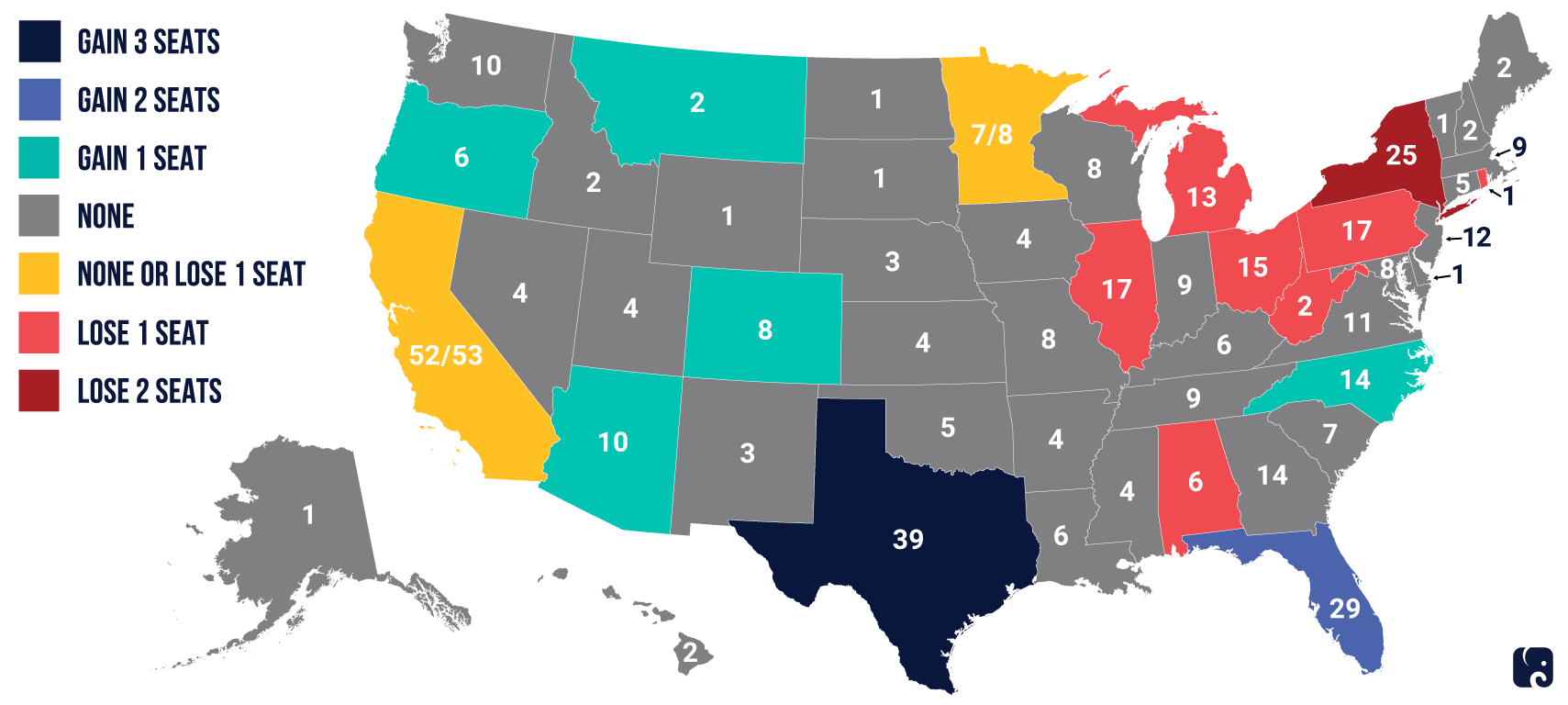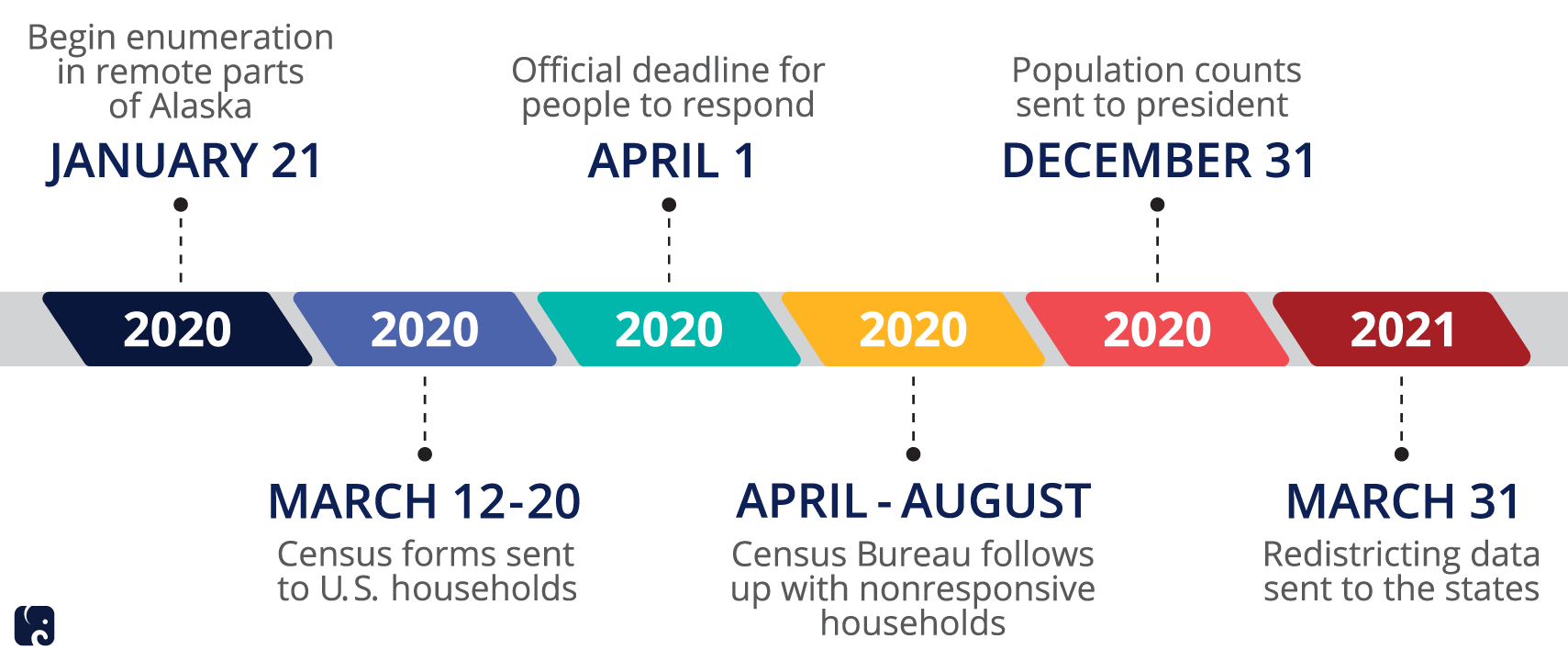The 2020 Census
KEY TAKEAWAYS
- The decennial census, first conducted in 1790, is taking place in 2020.
- The census is a count, as accurate as possible, of every person residing in the United States.
- It provides the basis for apportionment of Congressional seats, redistricting within states, and allocation of over $900 billion of federal funds.
The census has been conducted every decade since 1790. Because a representative government must know how many people reside within its borders, and where they live, in order to represent them effectively, the census is a keystone of our democracy. The 2010 census counted 308,745,538 people residing in America.
How The census will work
Article 1, Section 2 of the U.S. Constitution – as amended by Section 2 of the 14th Amendment – requires that an enumeration of all residents be taken every 10 years. The U.S. Census Bureau at the Commerce Department is responsible for conducting the count, and all residents are required by law to participate.
The census has asked a variety of questions over the years related to citizenship, gender, and other sociodemographic factors. The Census Bureau now collects much of this detailed information in its annual American Community Survey. The 2020 census will ask seven questions, including number of people living in a residence, gender, age, race, and the relationship of people in the home to one another. The data is kept confidential and is only to be used for statistical purposes. The 2020 census is estimated to cost $15.6 billion, and the bureau will hire about 500,000 temporary workers across the country to help with the count.
For the first time, people will be able to complete their census responses online. The Census Bureau plans an aggressive marketing and outreach campaign to inform people of this option and to encourage prompt responses. The bureau estimates that nearly half of U.S. households will respond via the internet, though people also will be able to return the forms by mail or by calling a “questionnaire assistance center.” The online questionnaire will be available in 12 languages in addition to English.
The bureau intends to emphasize prompt responses and the internet response option in an effort to reduce in-person, nonresponse follow up visits, which are the most expensive part of the census. The hope is that this will reduce costs, which have historically been a problem for the census. The Government Accountability Office has noted the average amount spent to count each housing unit in the country has “increased from $16 in 1970 to $94 in 2010,” adjusted for inflation. The bureau’s focus on the internet could pose a problem for rural areas, which are less likely to have good internet access and are already among the hardest to count.
a major impact on the federal government
The census has an enormous political, economic, and social impact. The results provide the basis for reapportioning congressional seats, redistricting within most states, and distributing billions of dollars in federal funds.
According to a report by George Washington University, the census guides 325 programs that distributed more than $900 billion in federal funds in fiscal year 2016. The programs include student loans and grants, housing assistance, health care, school lunch programs, transit grants, and crime-victim assistance. Census data also informs private sector investment and employment decisions.
The results of the 2020 census also will determine the apportionment of seats in the U.S. House of Representatives for the next decade. If current population trends continue, it is expected that there will be substantial changes for a number of states.
Predicted Census Reapportionment

Additional technology and challenges
In addition to the option for people to respond via the internet, the Census Bureau plans a number of technology initiatives to hold down costs. Census workers will be equipped with iPhones. They will use special apps to get work assignments, enter and transmit data, report expenses, and navigate to addresses. The bureau had planned for workers to use handheld devices for similar purposes in 2010, but the devices didn’t work as expected and the digital option had to be replaced with paper forms.
The bureau is working with the Department of Homeland Security to secure its networks and data against cyberattacks. The concern is not merely hypothetical. In 2016, Australia’s first online census was forced to shut down after a cyberattack crashed the survey website.
GAO has designated the 2020 census as “high risk,” largely due to cybersecurity risks and the need for the bureau to improve its “ability to manage, develop, and secure its IT systems.” The Census Enterprise Data Collection and Processing initiative, which began in 2014, is intended to consolidate a number of systems the bureau had previously used in conducting the census. GAO has noted that the census “relies heavily on the ability of the CEDCap initiative.”
Census Timeline

the citizenship question
In March 2018, Commerce Secretary Wilbur Ross issued a memorandum saying the Census Bureau would add a citizenship question to the 2020 form. Similar questions had been part of all but one census from 1820 through 1950. From 1970 through 2000, a citizenship question was included on a survey sent to a small percentage of the population. That survey was replaced by the American Community Survey, which has included a citizenship question since 2005. The memo explained that the Department of Justice had requested that the Commerce Department include the question in order to facilitate enforcement of Section 2 of the Voting Rights Act, which protects minority voting rights.
A variety of groups and states, concerned that the question might discourage participation in the census by minority and immigrant households, filed lawsuits. They argued that adding the question would violate the Constitution and statutes such as the Administrative Procedure Act. The Supreme Court held in June that the question did not violate the Constitution, but the stated reason for adding the question was pretextual and therefore in violation of the APA. The court prohibited Commerce from adding the citizenship question and remanded the case back to the district court to give the department a chance to provide a better rationale for its decision.
Facing logistical and statutory deadlines, President Trump issued an executive order directing federal agencies to provide the department with citizenship data they already possess.
Next Article Previous Article
